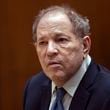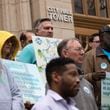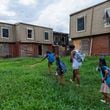Al Pierce snored so loudly that his wife would move to another room during the night. Even worse, said the 67-year-old owner of a wholesale plumbing supply business in Florence, S.C., he’d get up in the morning feeling fatigued and irritable and would have to nap in the late afternoon.
“I thought that’s the way life is,” said Pierce, who couldn’t disagree more with people who jokingly — or not — say sleep is overrated. “It is critical to good health.”
When his wife sought help for herself, and the doctor discovered her husband was causing her restlessness, Pierce underwent a sleep study and was diagnosed with obstructive sleep apnea, or pauses in breathing caused by a collapsed or blocked airway. When the brain signals to wake up, so breathing can resume, air may start flowing with a gasp or snore.
Apnea is one of a number of disorders that rob sufferers of recuperative sleep and, left untreated, can increase the risk of high blood pressure, heart attacks, strokes, obesity and diabetes.
Sleep deprivation also can lead to depression, a weakening of the immune system and the chance for work-related or driving accidents. Driver fatigue is blamed for 83,000 motor vehicle accidents and 850 deaths a year, according to the National Highway Traffic Safety Administration.
Sleep science is evolving and finding new ways to help patients. Pierce had an upper airway stimulating device, similar to a pacemaker, implanted in his chest in 2011 as part of a clinical trial and now uses it every night. He turns it on when he goes to bed, and it delivers what he describes as a mild pulse to his tongue and throat muscles to keep air flowing.
“I was so thrilled and overjoyed,” he said, “that I thought it might be a placebo effect. I wanted it to work so badly.” He went from 35 sleep apnea interruptions an hour to a full night’s rest.
Dr. Jonathan Pomerantz, an ear, nose and throat specialist, implanted the first Inspire Medical Systems Inc. stimulation device in Illinois at NorthShore University HealthSystem just over a year ago and considers it a “breakthrough” for sleep apnea patients for whom other treatments have failed. He likes that there are documented results from the clinical trial, published in 2014 in the New England Journal of Medicine.
“We don’t want to tell a patient just that we think it’s a good idea, but that we have data indicating there’s a good percent chance” of improvement, Pomerantz said.
His first patient for the device, Bart van Alphen, 39, who does sleep research on fruit flies at the Allada Lab at Northwestern University, had for decades stopped breathing as frequently as every other minute at night, Pomerantz said. After the device was implanted, his sleep apnea score went to zero.
“I’d wake up and not be able to focus on anything,” van Alphen said. “I’d read the same paper three or four times.” He tried the standard treatment, a CPAP (continuous positive airway pressure) machine, but found the mask through which air constantly flows a “nightmare that would wake me up several times a night. I just couldn’t get used to it.”
He ruled out other possible remedies — dental devices that move the jaw or surgery to remove tonsils or other soft tissue collapsing onto the throat — and liked that he’d be a kind of guinea pig for the stimulation therapy.
“It’s the only way the medical field can make progress, and it is FDA-approved (in 2014),” van Alphen said.
The device costs about $20,000, with surgery extra. Battery life is expected to be around 10 years. Insurance companies are reviewing requests on a case-by-case basis.
Studies show infants need 12 to 15 hours of sleep a day, teens need 8.5 to 9.5 hours and most adults need seven to nine hours. A National Sleep Foundation 2015 poll found that respondents saying they had very good or excellent quality of life got 30 additional minutes of sleep per night than those who rated their quality of life poor or fair.
Dr. Joseph Ojile, medical director and CEO of Clayton Sleep Institute near St. Louis, looks for what he calls mechanical causes only after behavioral ones are ruled out or addressed. About half of his patients can monitor their sleep habits at home; others are observed in a lab. The results, and a patient’s goals and motivation, decide what happens next, he said.
“The patient has an obligation to participate,” Ojile said, citing that 80 to 85 percent of those prescribed CPAP in his clinic are able to use it successfully, while nationwide only 50 to 60 percent are successful. He attributes the difference to follow-up and encouragement.
He said improvements to CPAP masks are making them more comfortable to wear by providing variations in cheek and nostril size and shape. A new device uses a pressurized mouthpiece to draw the soft palate forward and stabilize the tongue to keep open the airway, he said.
Ojile is seeing more patients walk in on their own and more referrals from medical professionals. “They’re realizing patients can’t get farther along in therapy until their sleep problem is fixed,” he said.





